What we learnt over 3 days trekking in the Colca Canyon
On our 3 month trip around South America we did plenty of incredible hikes. Colca Canyon was a really nice surprise, as we almost didn’t book it! After speaking with other travellers on the Peru Hop bus to Arequipa, we decided to book a 3 day trek in this deep canyon.
At 4,165m deep, the Colca Canyon in Peru is the third deepest canyon in the world.
The first deepest is Yarlung Zangbo River Grand Canyon in Tibet, second deepest is Kali Gandaki Gorge in Nepal.
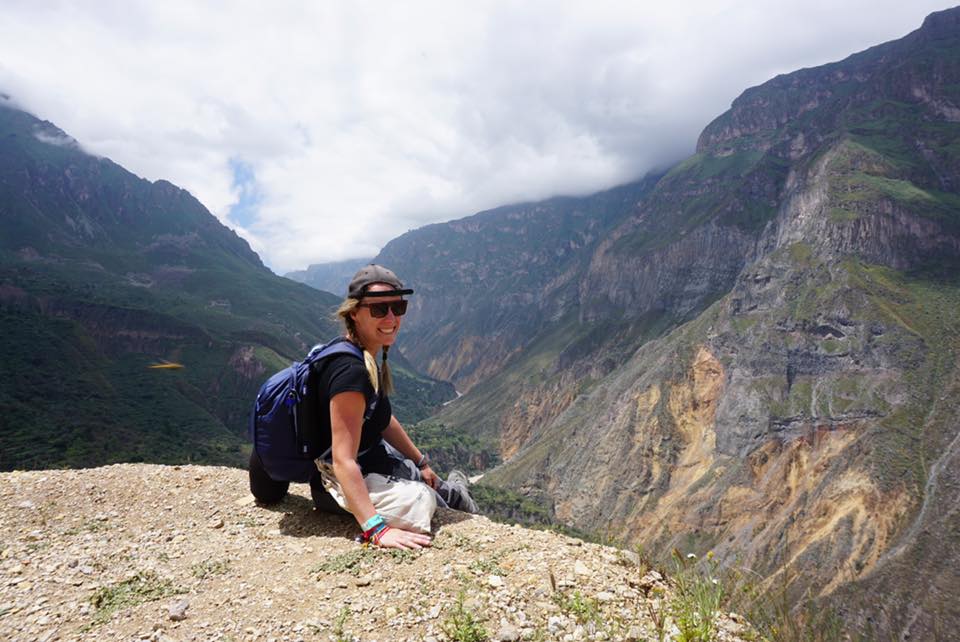
Colca Canyon Day 1
7km. Descend 3,300m to 2,450m.
On day one of the Colca Canyon trek I wake to my alarm at 2:40am. Arequipay Backpackers gives us two brown paper bags with breakfast inside, even though the tour is also giving us breakfast. At 3:20am a van turns up to drive us to the Colca Canyon.
Most of us are asleep in the van as we pass altitudes of up to 4,900m. At 5:30am I open my eyes to terrible visibility outside as we wind around the mountainside where snow covers the roads.
At 6am I hear someone puke. I look up to see Mark holding a plastic bag to his face. The guides in the van offer him coca leaves and a pat on the back.
We arrive in Chivay (3,600m) at 6:30am, where one of the guides hops out to pay for permits.
Cruz del Condor
Visibility is barely a metre ahead as we get closer to the condor viewing site. We can’t see a thing from Cruz del Condor, and the mist makes our hair damp while waiting on the edge of the cliff.
At around 9am we stop to learn about the condor. Adult condors can have a wing span of up to 3.5m. At the lookout, the clouds part before our eyes. Our guide, Juan Carlos, gives us coca leaves. I put some in my mouth and eat them (a little too quickly) while he explains that we should simply chew the leaves and then spit them out. Oops.
I start the descent taking each step carefully, and pick up speed as I begin to trust my knees the further down we go.
Juan Carlos stops many times to tell us about the few plants we see among the rocky landscape. “Quinoa is truly out of this world”. He tells us, looking at the plant in amazement. We collectively giggle.
We set foot at the bottom of the canyon (2,150m) at midday, I can hear the powerful river rapids. The Cinco Mayo river leads to the Colca river. Juan Carlos points to a pre-Inca canal that once connected farming irrigation to the Cinco Mayo river. We can see where the old canal once was.
We stop beneath a tree to try pacay – a white hairy fruit that tastes like coconut. Juan Carlos picks figs for us, and points out the different fruit trees around the area. At this point it’s clear he has a lot of knowledge to share about local plants. I’m all about it.
We reach our accommodation at 2pm, where we eat a warm soup followed by rice, veggies, alpaca and avocado. As we eat, we hear thunder. Soon, a huge storm hits.
Luckily there is no more hiking for the day, so we go to our huts for a rest. The rain is heavy, belting down on the thatched roof.
Dinner is served at 7pm. A tasty soup followed by more rice, veggies, fried sweet potato and halloumi.
After dinner, Juan Carlos emerges with a thermos of tea and tells us horror stories about Peru – one of which details a haunted hut right where we are staying. He won’t tell us which one, but the next morning we wake from strange dreams, and can’t help but wonder if the hut we are in is the haunted one.
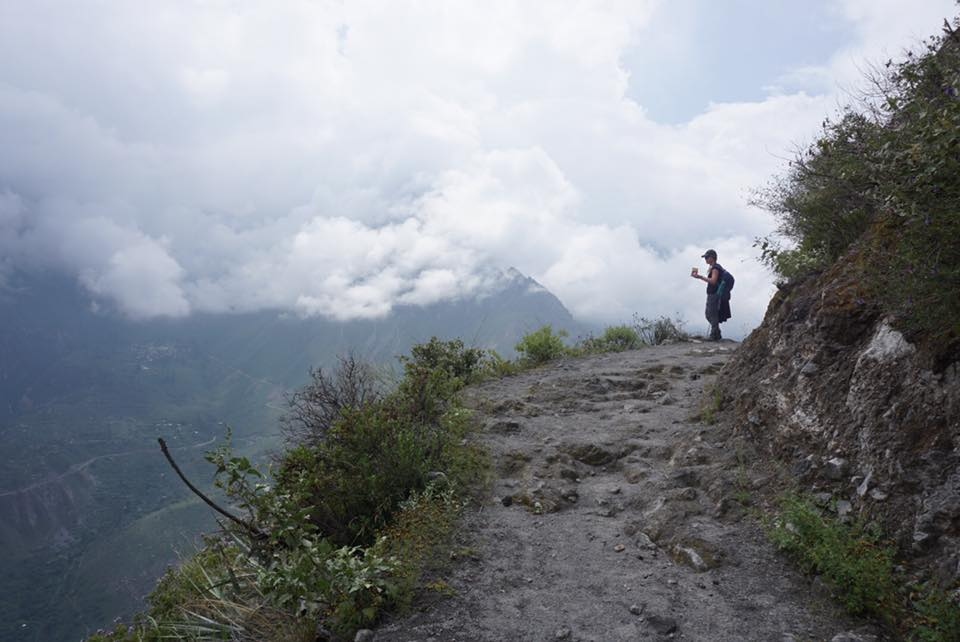
Colca Canyon Day 2
12km.
For breakfast it’s pancakes with banana and caramel sauce. At 8am we start hiking.
Juan Carlos tells us there’s one active volcano in the area, but not to worry because “It only spits ash, and the lava tubes are 2,000 years old.” I’m hopeful it doesn’t erupt for the first time in 2,000 years while we’re here.
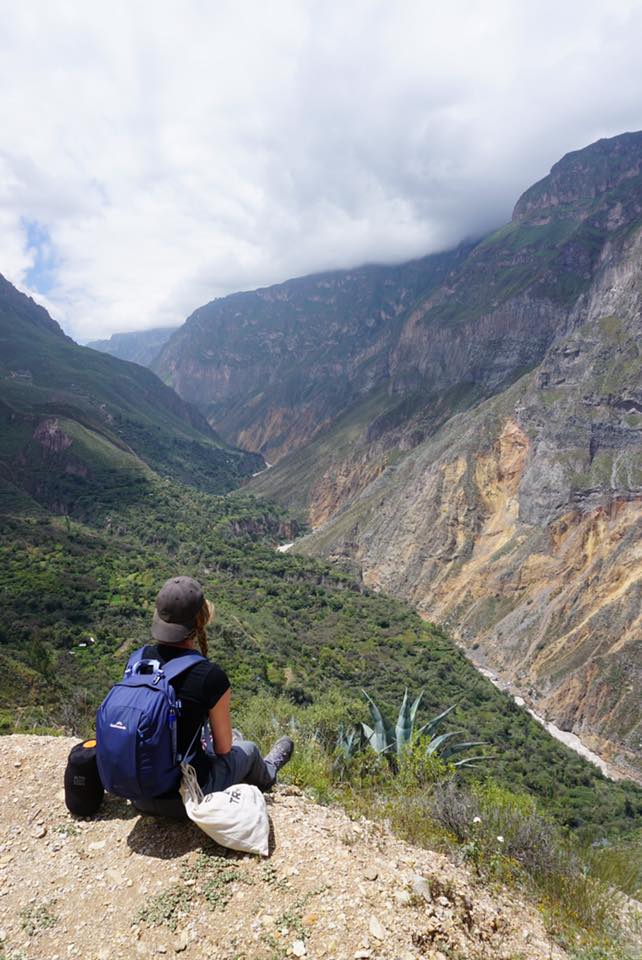
Coca Canyon plant education
Agave has many uses in Peru, and while I know it’s used to make tequila, I did not know the plant material is also used for building bridges and making hammocks.
Cherimoya leaves can be used as a mosquito repellant, or you can crush it up and smell it to relieve altitude symptoms. If a heavily pregnant woman drinks the milk from the stem of this plant, it could help induce labour, or as we’re told, “fetus come out”.
The next plant we learn about concerns me. “The milk of this plant can cause blindness if it touches your eyes. The red colour of the stem alerts danger. The only cure is the milk of a breastfeeding mother.” I’ve seen this plant a lot in the canyon, and steer clear as we move forward.
The molle plant, or pink pepper, has red berries. “Peel off the skin and lightly crunch the seed. At first it’s sweet, then spicy.” Mark isn’t a fan, but I don’t mind the taste of it.
Morning tea at Cochellia village
We make it to Quilla Lodge at 9:40am (2,600m). We are given pomegranate and tuna – which is the fruit of the cactus.
Cochellia village is quite large, if you’re trekking by yourself you could find accommodation here.
The population here is diminishing. We’re told most of the children move to Arequipa or Lima for work and university, as young people are more frequently moving out of the Colca Canyon. We see many abandoned homes, and we’re told home owners deliberately leave steel spikes poking out the top of their roof so that they don’t have to pay taxes, as the house ‘isn’t finished’.
We stop at a small museum. “Llama testicles are used to carry objects. Snakes are used as heat packs – their muscles are warm, so they cut them open and wrap them around a wound.”
The oasis
When we reach the Tropical Lodge, waterfalls trickle down from the mountain into a canal. The descent to the oasis is beautiful. The Tropical Oasis (2,140m) is a huge property with dorm rooms, a soccer field (where they play at 4pm every day), and a huge pool.
For lunch we eat soup, rice, veggies and fried potato. We’re playing soccer with locals on the field when construction workers come over to tell us they’re about to use dynamite on the rocks, “Don’t be afraid when you hear it.”
At dinner we eat soup followed by spaghetti with carrots and cheese. Afterwards, Juan Carlos carries out a plate of tea, and tells us we’re leaving at 4:45am to begin the 3 hour hike to the top.
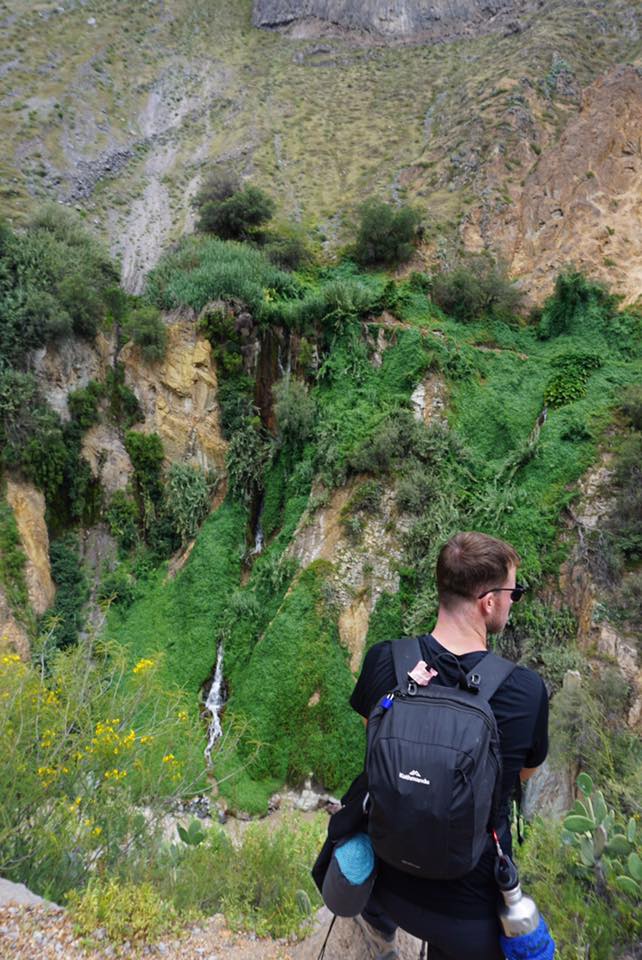
Colca Canyon Day 3
5km. Ascending 1,000m.
Our alarm goes off at 4:25am. Juan Carlos is waiting for us in the kitchen to start the hike in the dark, where our head-torches will light the way.
When we begin hiking we’re at just 2,140m altitude.
At 6:20am we make it half way to 2,760m. The clouds are beginning to close in all around us.
At 8:00am we reach the top of the canyon (3,300m) after 4km of hiking up steps and steep slopes.
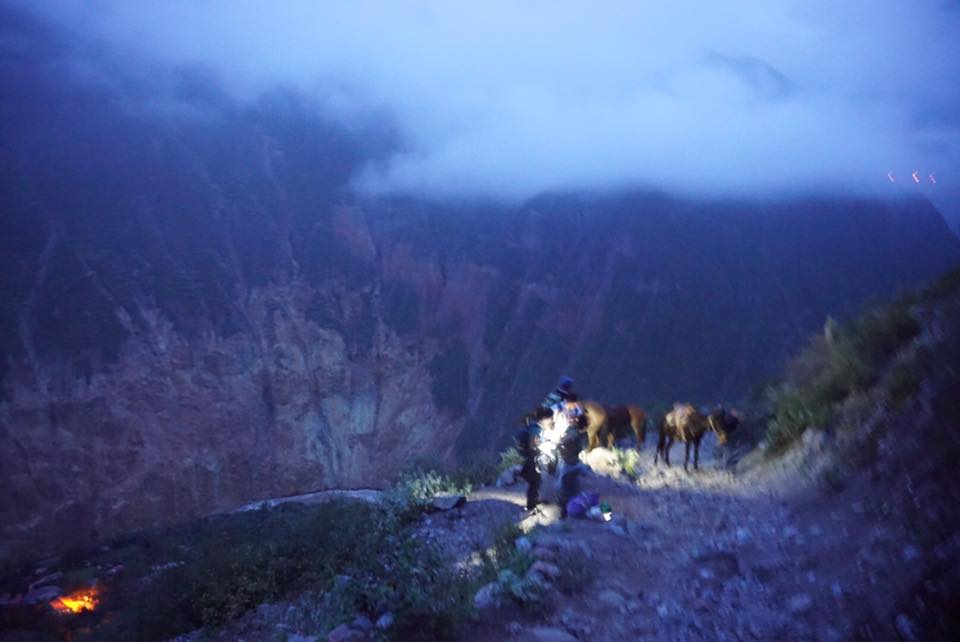
We continue hiking another kilometre to the town of Cabanaconde (3,310m) where we eat breakfast in a busy cafe. It’s Sunday, and we can hear church prayers playing through a megaphone in the town square.
At 9:30am we all climb in to a bus to reach the next stop. Juan Carlos swaps with another guide, as it’s time for him to go straight back into the canyon for another tour. In peak season he does the Colca Canyon trek non-stop. In low season, he studies German Monday-Wednesday, trekking any time from Thursday-Sunday.
In the distance we see Sabancaya volcano erupting, a 5,976m tall stratovolcano approximately 70km northwest of Arequipa.
Poye hot springs
At 11am we reach Poye hot springs (3,500m). First, we have a hot shower to rinse off. We spend an hour sitting in the warm water, relaxing our muscles after hiking 24km in just 3 days.
For lunch we drive to Chivay and eat a buffet meal at Los Portales de Chivay (3,660m). Afterwards, we drive 40 minutes to Pachamama, a 4,800m-high viewing point where (on a clear day) you can see volcanoes all around. It’s raining when we arrive, so we aren’t able to see the volcanoes. It starts hailing as we drive down a windy road.
Next, we stop at a national reserve (4,380m) to see wild llamas and alpacas running around. Luckily, we are ahead of the storm, so we walk outside without snow.
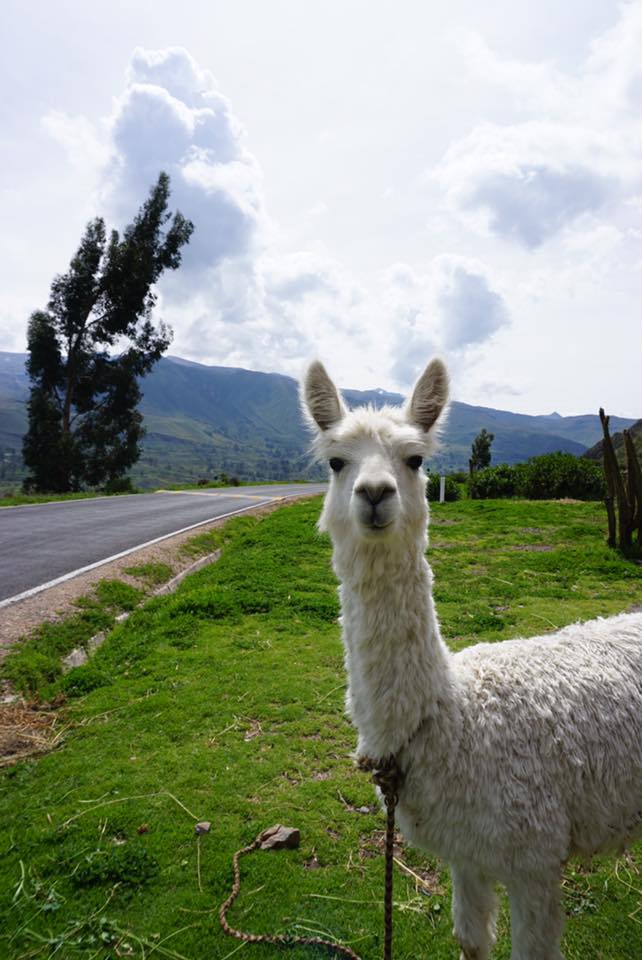
The bus drops us back in Arequipa at 5pm, where we walk to the Plaza for dinner, and eat at a pizza joint. As we sit and eat, a religious procession takes place in the plaza for Easter week. We’re not even one tiny bit religious, but we’re glad we’re here at this time of year to see the culture come to life.
Why you should trek Colca Canyon with a tour group
- For approximately $60 AUD you’ll get a 3-4hr mini van from Arequipa to Colca Canyon, three breakfasts, two dinners, two lunches, two nights of accommodation and an English speaking guide
- If you hike solo, you’d have to find your own way to the canyon, book all accommodation when you arrive, pay for your meals while hiking, and you won’t have a guide to share all the juicy details about the third deepest canyon in the world + all of the local plant life (if you’re into that kind of thing)
- Your guide will give you a wealth of information about the region, such as historical facts, legends and myths in the area, and how various plants were used for medical purposes and day-to-day life
- You’ll sample fruit straight from the plants, such as the tuna (fruit of the cactus, believe it or not) and the Muskha. Without a local guide you might end up sampling the wrong plant…
- While we normally like to hike solo, we’re really glad we went with a small tour group for the Colca Canyon.
Any questions? Ask away!
This post contains affiliate links.
January 23, 2024
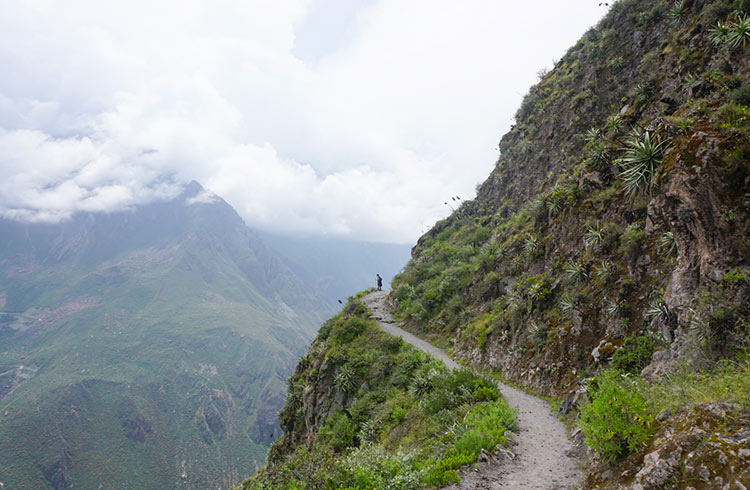
Join the discussion!